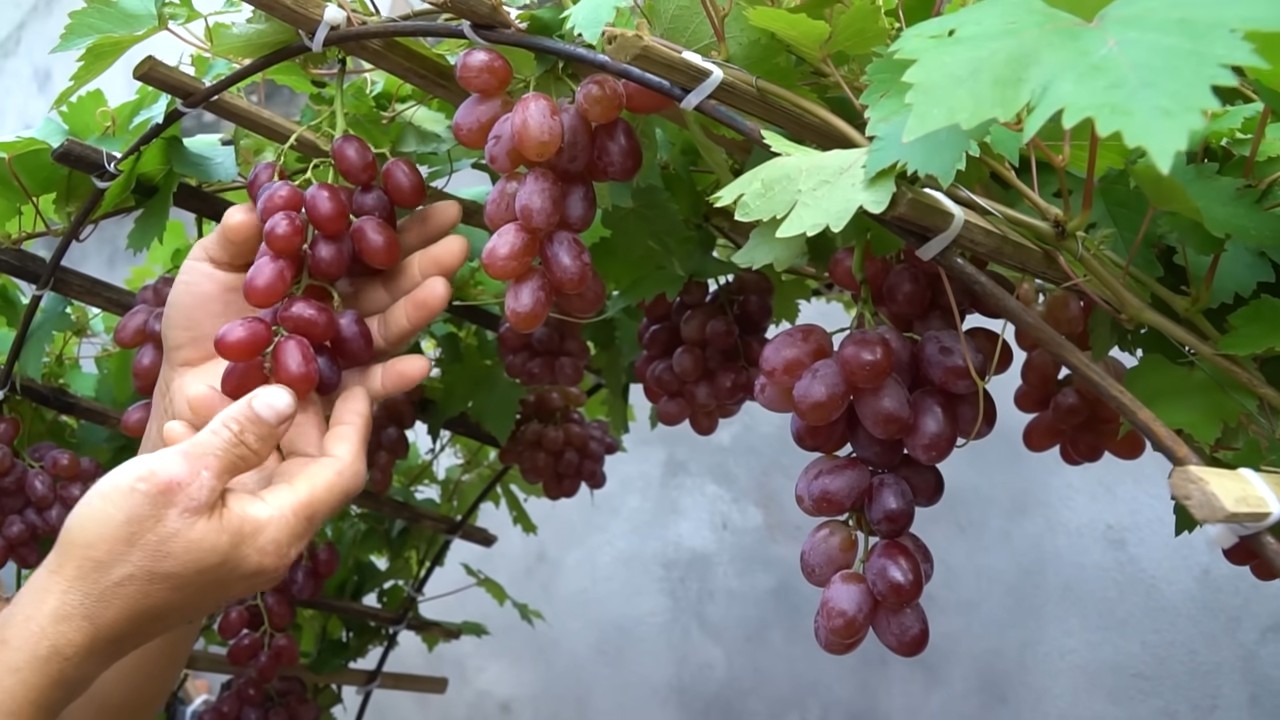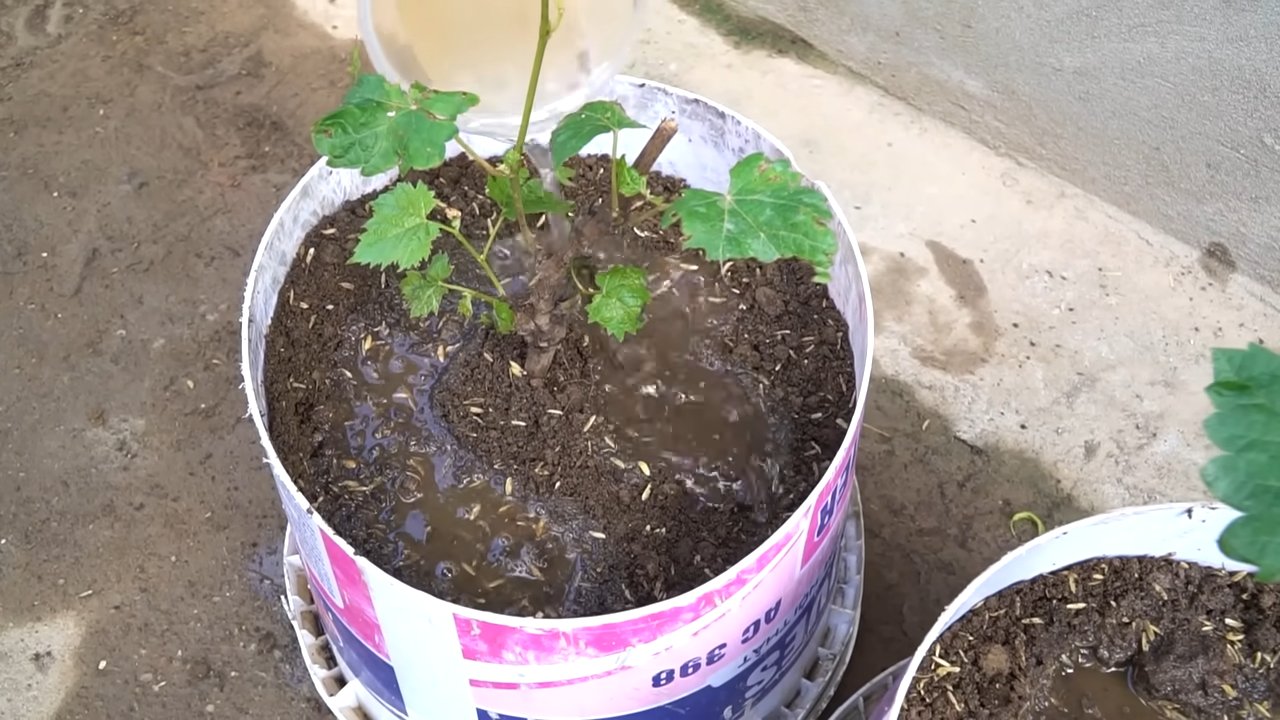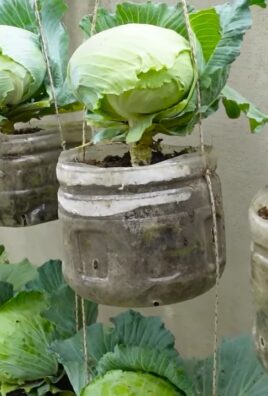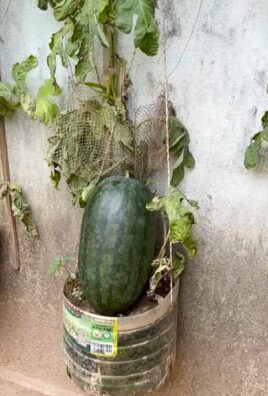Growing Grapes at Home might seem like a task reserved for sprawling vineyards in Napa Valley, but I’m here to tell you that with a little know-how, you can cultivate your own sweet, juicy grapes right in your backyard! Forget those expensive grocery store grapes – imagine plucking sun-ripened fruit straight from your own vine.
Grape cultivation boasts a rich history, dating back thousands of years to ancient civilizations like the Egyptians and Romans, who revered grapes not only for their delicious fruit but also for their winemaking potential. Today, the allure of growing your own grapes remains strong. But why should you embark on this rewarding journey?
Well, for starters, growing grapes at home allows you to control exactly what goes into your food. You can avoid harmful pesticides and herbicides, ensuring a healthier and more natural treat for you and your family. Plus, it’s incredibly satisfying to nurture a plant from a tiny seedling to a thriving vine laden with fruit. This DIY guide will provide you with simple, effective tricks and hacks to make growing grapes at home easier than you ever thought possible. From choosing the right variety for your climate to mastering pruning techniques, I’ll walk you through every step of the process, so you can enjoy a bountiful harvest year after year. Let’s get growing!

Growing Grapevines in Your Own Garden: Your DIY Guide for a Bountiful Harvest
Hello wine lovers! Have you ever dreamed of harvesting your own juicy grapes in the garden? I can tell you, it’s an incredibly satisfying feeling! And the best part: it’s not as hard as you might think. With a little patience, love, and this comprehensive DIY guide, you too can soon be enjoying your own grapes. Let’s get started!
The Basics: What You Need to Get Started
Before we dive into the details, let’s make sure you have everything you need. Here is a list of the most important things:
- Grapevine plants: Choose a variety that is suitable for your climate. Do your research! Local nurseries are often a goldmine of knowledge.
- A sunny location: Grapevines love the sun! At least 6-8 hours of direct sunlight per day is ideal.
- Well-draining soil: Waterlogging is the enemy! The soil should be loose and well-draining.
- A trellis: Grapevines need support. A trellis, a pergola, or a fence is perfect.
- Garden tools: Spade, shovel, garden shears, gloves, watering can or garden hose.
- Fertilizer: A balanced fertilizer for fruit plants is ideal.
- Mulch: Helps to retain moisture and suppress weeds.
Step-by-Step Guide: How to Plant Your Grapevines
Now let’s get down to it! Follow these steps to successfully plant your grapevines:
- Choose the right time: The best time to plant grapevines is in the spring or fall, when the temperatures are mild. Avoid planting during frost or extreme heat.
- Prepare the soil: Dig a hole that is twice as wide and deep as the root ball of the vine plant. Loosen the soil at the bottom of the hole to improve drainage. Mix compost or well-rotted manure into the excavated soil to enrich it.
- Plant the vine: Carefully remove the vine plant from the pot and gently loosen the roots. Place the plant in the hole so that the top of the root ball is level with the soil surface. Fill the hole with the prepared soil mixture and press it down lightly.
- Water: Water the vine plant thoroughly to saturate the soil.
- Mulch: Apply a layer of mulch around the base of the plant to retain moisture and suppress weeds. Make sure the mulch is not directly touching the trunk of the plant.
- Install the trellis: Install the trellis near the vine plant. The vines will eventually cling to it and grow up it.
The First Months: Care and Training of the Young Vines
The first few months are crucial for the growth and development of your grapevines. Here are some important care measures:
- Regular watering: Keep the soil moist, but not soggy. Water regularly, especially during dry periods.
- Fertilizing: Fertilize the vine plant in the spring with a balanced fertilizer for fruit plants. Follow the instructions on the packaging.
- Weed control: Keep the area around the vine plant free of weeds. Weeds compete with the vines for nutrients and water.
- Training the vines: Guide the young shoots of the vines onto the trellis. Gently tie them with garden wire or plant ties. The goal is to develop a strong main shoot that will serve as the trunk of the vine.
Pruning: The Key to a Bountiful Harvest
Pruning is an essential part of grapevine care. It helps to maintain the shape of the vine, promote fruit production, and prevent diseases.
Winter Pruning: Laying the Foundation for the Next Year
Winter pruning is done during the dormant phase of the vine, usually in late winter or early spring, before the buds swell.
- Remove dead, diseased, or damaged wood: Start by removing all dead, diseased, or damaged shoots.
- Select the fruiting canes: Choose the strongest and healthiest shoots that grew last year. These shoots will bear the fruit next year. The number of fruiting canes depends on the grape variety and the desired yield.
- Shorten the fruiting canes: Shorten the selected fruiting canes to a certain number of buds. The number of buds depends on the grape variety and the desired yield. A rule of thumb is to shorten the canes to 8-12 buds.
- Remove all other shoots: Remove all other shoots that were not selected as fruiting canes.
Summer Pruning: Promoting Fruit Development
Summer pruning is done during the growing season, usually in the summer.
- Remove suckers: Suckers are small shoots that grow from the leaf axils of the main shoots. They consume unnecessary energy and should be removed.
- Remove leaves that shade the grapes: Remove leaves that shade the grapes to increase sun exposure and promote ripening.
- Shorten long shoots: Shorten long shoots to improve air circulation and prevent diseases.
Diseases and Pests: What You Need to Know
Like all plants, grapevines can be affected by diseases and pests. Here are some of the most common problems and how you can combat them:
- Downy Mildew: A fungal disease that appears as yellow spots on the leaves and a white, fluffy coating on the underside of the leaves. Combat downy mildew with fungicides.
- Powdery Mildew: A fungal disease that appears as a white, powdery coating on the leaves, shoots, and grapes. Combat powdery mildew with fungicides.
- Phylloxera: A pest that attacks the roots of the vines and can lead to the death of the plant. Use resistant grape varieties or combat phylloxera with insecticides.
- Birds: Birds can eat the grapes before they are ripe. Protect your grapes with nets.
The Harvest: The Reward for Your Effort
After all the work and patience, the time has finally come: the harvest! The timing of the harvest depends on the grape variety and the desired degree of ripeness.
- Determine the ripeness: The ripeness of the grapes can be determined by the sugar content, acidity, and taste. Use a refractometer to measure the sugar content, or simply taste the grapes. They should be sweet and aromatic.
- Harvest the grapes: Cut the grape clusters with garden shears. Be careful not to damage the grapes.
- Enjoy the grapes: Enjoy your home-harvested grapes fresh from the vine or use them to make juice, wine, or jam.
Additional Tips for Successful Grapevine Cultivation
Choose the right grape variety: Do your research on the different grape varieties and choose one that is suitable for your climate

Conclusion
So, there you have it! Growing grapes at home might seem daunting at first, but with the right knowledge and a little dedication, you can transform your backyard into a personal vineyard. The satisfaction of harvesting your own juicy grapes, knowing you nurtured them from vine to table, is truly unparalleled. This DIY trick, focusing on [Specific aspect of grape growing, e.g., “proper pruning techniques” or “creating the ideal soil mix”], is a game-changer because it directly addresses [Explain why this aspect is crucial, e.g., “the most common reason for grape-growing failure” or “the key to maximizing fruit yield”].
Why is this a must-try? Because it empowers you to take control of your grape-growing journey, ensuring healthier vines, more abundant harvests, and ultimately, a more rewarding experience. Imagine the possibilities: fresh grapes for snacking, homemade grape juice, delicious jams and jellies, or even venturing into the world of home winemaking!
Don’t be afraid to experiment! Consider these variations to tailor the process to your specific needs and preferences:
* Different Grape Varieties: Explore different grape varieties suited to your climate and taste preferences. From the classic Concord to the delicate Pinot Noir, each variety offers a unique flavor profile and growing requirements. Research which grapes thrive in your region and choose accordingly.
* Trellising Systems: Experiment with different trellising systems to optimize sunlight exposure and airflow. A well-designed trellis can significantly improve grape quality and yield. Consider options like the Geneva Double Curtain, the Vertical Shoot Positioning system, or a simple wire trellis.
* Organic Pest Control: Embrace organic pest control methods to protect your vines from unwanted visitors. Neem oil, insecticidal soap, and beneficial insects can help keep your grapes healthy without the use of harsh chemicals.
* Soil Amendments: Tailor your soil amendments to the specific needs of your grape variety. Some grapes prefer slightly acidic soil, while others thrive in more alkaline conditions. Conduct a soil test to determine the pH level and nutrient content of your soil and adjust accordingly.
We strongly encourage you to give this DIY trick a try. The rewards are well worth the effort. And most importantly, share your experiences with us! We’d love to hear about your successes, challenges, and any tips you’ve discovered along the way. Your insights can help other aspiring grape growers achieve their dreams of a bountiful harvest. Let’s cultivate a community of thriving home vineyards, one grape at a time! Remember, mastering the art of growing grapes at home is within your reach, and this DIY trick is your first step towards a fruitful and fulfilling journey.
Frequently Asked Questions (FAQ)
What is the best time of year to plant grape vines?
The best time to plant grape vines is typically in early spring or late fall, when the vines are dormant. Planting during these times allows the roots to establish themselves before the heat of summer or the cold of winter sets in. In warmer climates, late fall planting is often preferred, while in colder climates, early spring planting is recommended to avoid frost damage to newly planted vines. Be sure to check your local climate and consult with a local nursery or agricultural extension office for specific recommendations.
How much sunlight do grape vines need?
Grape vines require at least 6-8 hours of direct sunlight per day to thrive. Sunlight is essential for photosynthesis, which is the process by which plants convert light energy into chemical energy for growth and fruit production. Insufficient sunlight can lead to reduced yields, smaller grapes, and poor fruit quality. Choose a planting location that receives ample sunlight throughout the day, and avoid areas that are shaded by trees or buildings.
What type of soil is best for growing grapes?
Grapes prefer well-drained soil that is slightly acidic to neutral in pH (between 6.0 and 7.0). The soil should be rich in organic matter and have good drainage to prevent root rot. Heavy clay soils can be amended with compost, sand, and other organic materials to improve drainage and aeration. Sandy soils may need to be amended with compost and other organic materials to improve water retention. A soil test can help you determine the pH level and nutrient content of your soil and guide you in making necessary amendments.
How often should I water my grape vines?
The watering needs of grape vines vary depending on the climate, soil type, and stage of growth. Newly planted vines need to be watered regularly to keep the soil moist but not waterlogged. Established vines are more drought-tolerant but still need to be watered during dry periods. Water deeply and infrequently, allowing the soil to dry out slightly between waterings. Avoid overhead watering, as this can promote fungal diseases. Drip irrigation is an efficient way to water grape vines, as it delivers water directly to the roots.
How do I prune my grape vines?
Pruning is essential for maintaining the health and productivity of grape vines. The timing and method of pruning depend on the grape variety and the training system used. In general, grape vines are pruned during the dormant season (late winter or early spring) to remove dead, damaged, and unproductive wood. Pruning helps to shape the vine, improve airflow, and promote fruit production. Consult with a local viticulturist or agricultural extension office for specific pruning recommendations for your grape variety and training system.
What are some common pests and diseases that affect grape vines?
Grape vines are susceptible to a variety of pests and diseases, including aphids, Japanese beetles, grape phylloxera, powdery mildew, downy mildew, and black rot. Regular monitoring of your vines can help you detect problems early and take appropriate action. Organic pest control methods, such as neem oil, insecticidal soap, and beneficial insects, can help to control pests without the use of harsh chemicals. Fungicides can be used to prevent and control fungal diseases. Proper pruning and good air circulation can also help to reduce the risk of disease.
How long does it take for grape vines to produce fruit?
Grape vines typically take 2-3 years to produce a significant crop of fruit. The first year after planting, the vines will focus on establishing their root system. In the second year, they may produce a small amount of fruit. By the third year, they should be producing a more substantial crop. The exact time frame can vary depending on the grape variety, the growing conditions, and the care provided.
Can I grow grapes in containers?
Yes, you can grow grapes in containers, but it requires careful planning and attention. Choose a large container (at least 15-20 gallons) with good drainage. Select a grape variety that is well-suited to container growing, such as dwarf or compact varieties. Use a well-draining potting mix and provide regular watering and fertilization. Container-grown grapes may need to be pruned more frequently than those grown in the ground.
How do I know when my grapes are ripe?
The ripeness of grapes depends on the grape variety and your personal preference. In general, grapes are ripe when they are plump, juicy, and easily detach from the vine. The color of the grapes will also change as they ripen, depending on the variety. Taste the grapes to determine if they are sweet enough for your liking. You can also use a refractometer to measure the sugar content of the grapes.
What can I do with my homegrown grapes?
The possibilities are endless! You can eat them fresh, make grape juice, jam, jelly, or even wine. You can also use them in baking, salads, and other dishes. Homegrown grapes are a delicious and rewarding treat that you can enjoy in many different ways.




Leave a Comment